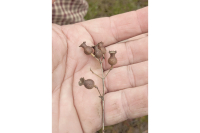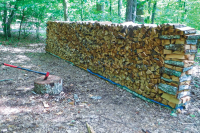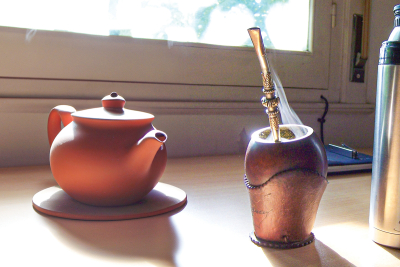Planted in the mountains: WNC botanist reflects on a lifetime of discovery
Dan Pittillo has made his name as a botanist, but he could easily have ended up a dairy farmer instead.
Born in Henderson County the oldest of five, Pittillo entered the world in 1938, when the Great Depression was in full swing and people were used to not having much. For the first two years of his life his parents didn’t even have a house — the family lived with his grandparents while his father worked to build one.
Planting for pollinators: Waynesville couple seeks to educate on the benefits of native bees
Brannen Basham spends more time puttering around the yard than the average homeowner, but the result is not what most people would picture when asked to envision a well-cared-for lawn.
Oil Nut, that most curious fruit
For Elizabeth and me, the fall season is one of the most invigorating times to get out in the woods and prowl around. Many of the most beautiful wildflowers found in the Blue Ridge, especially the lobelias and gentians, are then coming into their own. And most of the others are in their fruiting stages. The transition from flower to fruit (or seed) is both logical and enjoyable. The varied fruiting forms — which run the gamut from drupes, berries, and pomes to follicles, utricles, loments, and legumes to capsules, achenes, samaras, and nuts — are as attractive and intricate in their own way as any wildflower. And they are, after all, the grand finales of the germination-flowering-pollination cycle.
Mis-identifying mushrooms is a risky mistake
Editor’s note: This article first appeared in The Smoky Mountain News in September 2004.
The cool and humid forests and valleys of the Smokies region are said to be home to a greater variety of mushrooms and related fungi species than any other place on earth. To some, mushrooms seem spectral and fantastic — like something out of a dream world, best avoided. To others, they represent adventure — objects to be sought out, identified, and understood for their own intrinsic beauty and place in the ecological cycle. And then there are those who pursue them as delicacies — gourmet items that wind up on the kitchen table.
The Naturalist's Corner: Hearts are a-bursting
I started out the front door, in the early morning light the other day, to check on the whereabouts of our newest family member Remi, a young part Shar-Pei mix we adopted from the shelter last May. Remi has recently decided when she goes out in the morning part of her doggy-duty is to go down the road to our neighbor’s house and bark, and we’ve been trying to convince her that’s really not necessary. While I was focused on Remi, trying to make sure I caught up with her before she had time to make her morning announcements I couldn’t help but notice the incandescent red glow coming from the dappled woods.
Off the beaten path: Alarka Institute leads quest for rare mountain flower
For even the most woods-savvy of plant lovers, a blooming mountain camellia is a rare to non-existent sight.
A member of the tea family, it’s picky about its habitat, easily susceptible to drought and fire, and reticent to reproduce. All that adds up to a tenuous existence in scattered, isolated populations through the Southern Appalachians. To find a mountain camellia, you’ve got to know where to go and what to look for, and be willing to tromp through the backcountry until you see it.
Bracken among the world’s most common plants
“Here and elsewhere, bracken is such an aggressive plant that one wonders why it has not taken over the world.”
— R.C. Moran, A Natural History of Ferns (2004)
Bracken fern is said to be one of the five most common plants in the world. Standing up to five feet high, it is the coarse leathery fern you have no doubt encountered in disturbed areas, thickets, and dry open woodlands.
The Naturalist's Corner: Back in the saddle
I have had, since 2004, one of the best gigs any bird nerd could ask for. That was when I was awarded my first U.S. Forest Service (FS) bird survey contract for three districts in the Pisgah National Forest. To say I didn’t know what I was getting into would be a great understatement. I was given some over-the-counter maps and a list of coordinates and was told all I had to do was find the points, mark them and then survey them.
Birch stills were once plentiful in the mountains
Throughout spring the pendent catkins of sweet birch (Betula lenta) will be dangling gracefully in the wind in rich woodland settings below 4000 feet.
Catkins are the male pollen-carrying portion of the sweet birch (Betula lenta), also known as black, cherry, or mahogany birch.
From enemy to ally: Kudzu Camp seeks to overturn misconceptions
It was 1983 when Avram Friedman first rolled into Sylva, driving the repurposed school bus that was home for him, his wife and their 18-month-old son during their cross-country trek from California. They were looking for a more permanent living situation, and while most would have passed over the 3-acre property that is still the Friedman family home, to Avram it was perfect — mainly because the land and the house combined cost only $12,000.
“We didn’t have any money,” Avram laughed. “We were just poor hippies.”









